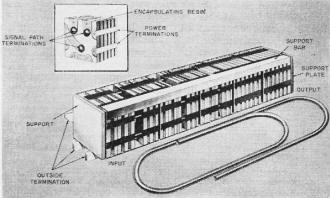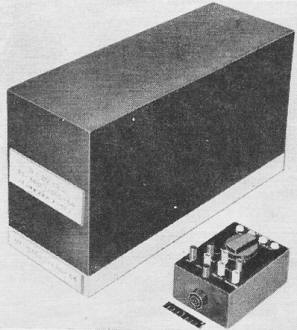Micro-Modules |
||
"Micro" as applied to electronics is relative, depending on which decade you reference. In the 1940s, a micro-size electronic assembly might have included "peanut" vacuum tubes and even some sort of printed circuit board. That was a huge step down in size from standard size tubes with point-to-point wiring between tube sockets and solder lugs on switches, potentiometers, variable capacitors, etc. Fixed value leaded resistors, capacitors, and inductors, and transformer wires connected to those lugs as well as to many terminal strips installed specifically for making connections. See Bob Davis' Montgomery Ward Airline 62-437 "Movie Dial" Radio for a look at what a rat's nest those chassis were. Once transistors came on the scene in the 1950s, a new round of miniaturization took place based on not just a significantly smaller size of solid state transistors and diodes, but their lower voltage and current requirements meant ancillary components could be made smaller as well due to lower voltage and power handling requirements. By the 1960s, yet another version of "micro" was defined by integrated circuits that combined functions into a single package rather than requiring discrete components for each circuit. The 1970s saw a major infusion of microprocessors that replaced analog functions and added capability. Mixed signal integrated circuits took off in the 1980s, further reducing circuit board real estate for an equivalent number of features, which greatly facilitated person computer success. Cell phones and the Internet drove 1990s technology size reduction, then a host of new wireless devices and interconnecting interfaces (WiFi, Bluetooth, ZigBee, GPS, etc.) in the new century. To round out the decades of achievement, the 2010s birthed the Internet of Things (IoT) and ultra wideband wired and wireless connectivity via 4G and 5G. Micro-Modules Fig. 1. Evolution of a micro-module in actual size. The basic wafers are at left. Next, from top to bottom are the following wafers: resistors, resistors. coil, capacitor, transistor, and diode. The complete micro-module is at the right.
Electronic equipment of the future will be Lighter in weight, smaller in size thanks to this technique. The electronic and radio-television industries today are at the threshold of a new and revolutionary change in the design and manufacture of component parts for equipment. So great is this change that, ultimately, it will affect the size and weight of all electronic, radio, television, and other communications equipment - with possible reductions to one-tenth or more. The objectives of this revolutionary change are reduced size and bulk and decreased weight. These objectives are met through micro-miniaturization and the production of micro-modules. Conventional transistors and miniature parts being used in today's radio and television sets and other electronic and communications equipment are not small enough for the purpose. There is a need for a further decrease in size, bulk, and weight-requirements that are responsible for the startling research and design advances in micro-miniaturization. Although ultimately applicable to all kinds of electronic and communications equipment, the present program of research and design was triggered directly by the urgent need for compact, lightweight equipment for the Army Signal Corps. This requirement runs the gamut from small portable radios to complex trunk switching centrals, from television sets to electronic data processing equipment, and even to satellite instrumentation. Here, in a military environment, was and is the urgent need for extreme miniaturization. After months of theorizing, exploratory tests, and experimental design, in cooperation with American industry, the Army Signal Corps has now reached the stage where actual development contracts have been placed - notably one with RCA for five million dollars. An "industrial preparedness measure," this marks only the start toward refinement and utilization of multi-function micro-modules. Micro-Assemblies The key to the future program of micro-miniaturization is the fabrication of extremely small, solid-state devices, known as micro-modules. Although micro-modules can be constructed in any physical shape of cover or envelope, most common will be the standardized type shown at the right in Fig. 1. This is a complete part composed of a number of sub--assemblies, each constructed in a common wafer shape. The wafer may be of ferrite, barium titanate, or even metal, as required. Each wafer measures 3/10 inch by 3/10 inch and is only 1/100 inch thick. Miniature elements of a sub-assembly are selected and arranged to provide a specific circuit function. For example, as shown (from top to bottom) in Fig. 1, these sub-assemblies could be a number of resistors, a coil, capacitor, transistor, or diode. When these particular sub-assemblies are stacked together, they form a complete micro-module - in this case the tuning, detecting, or amplifying stage of a five-stage broadcast-band radio receiver.
Fig. 2. Two versions of the same homing equipment. Larger unit uses present-day miniature production, while smaller device (above ruler) uses the micro-modules. Fig. 3. Enlarged micro-module and multi-unit assembly of several micro-modules - compared to size of small paper clip. Fig. 4. Circuitry of earth satellite using conventional present-day components. Fig. 5. Satellite circuitry using micro-modular construction. Compare with Fig. 4. Fig. 6. Same radio navigating gear made with present and micro-modular techniques. After stacking, the sub-assemblies are encased in a mold or envelope of standard size to form a solid body. Appropriate connectors are provided for plugging into another micro-module or a socket of another part of the complete equipment. In final form, a micro-module is three dimensional and approximately cubic in shape for most effective space utilization. A greatly enlarged view of a typical micro-module is shown in Fig. 3, with identification of the signal circuit and power terminations. A number of different solid-state micro-modules may be connected together, by means of connecting bars and supporting braces, o achieve the desired circuitry. Note the size of the micro-module when compared to a small paper clip, both of which have been enlarged the same number of times in Fig. 3. The mechanical structure of micro-modules makes them ideally suited for automatic manufacturing - automation - with completely controlled production processes. This will mean greater reliability at less cost than the conventional parts and components of today. Use of micro-modules will mean greatly simplified servicing and maintenance. An entire module assembly, consisting of 30 to 40 electronic elements, can be replaced easily without the necessity for testing the individual elements of a stage or unit separately. If trouble develops, the entire module can be removed and replaced. Applications For a comparison of the functional and mechanical advantages of micro-modules, see Fig. 2 which represents the electronic homing assembly of one kind of Army missile. In the larger device, present-day miniature tubes, components, and transistors are used with economy of space, with bulk and weight held to an absolute minimum. But even this is no match for the assembly of micro-modules shown below it (and just above the ruler), which represents a reduction of more than ten to one in size, bulk, and weight. Through the use of the micro-module technique more than 50 separate electronic parts and components of the larger homing assembly are replaced by a single multi-unit micro-module. High-thrust rockets and earth satellites also require elaborate electronic controls, data recording, storage, and transmitting equipment. Since bulk and weight are luxuries which cannot be indulged in rockets and satellites, the use of micro-modules is of extreme significance. Some of the present-day components of a typical earth satellite are shown in Fig. 4. All parts are miniature, printed circuits abound, and every effort has been made to conserve space and weight. Yet when the identical circuit equivalent is in micro-modular form (Fig. 5) there is a reduction in weight and bulk to less than one-tenth of the original. Since satellite instrumentation requires a number of such electronic circuits - for surveillance, memory storage, telemetering, and other functions - the immediate application of micro-miniaturization could not be more appropriate than in this field of inter-space exploration and operation. In another operational instance, large commercial airliners presently require literally thousands of pounds of gear for communication, navigation, traffic control, and other electronic functions. As a typical example of only one type of radio navigation equipment for aircraft, there is the bulky apparatus shown in Fig. 6, and its electronic equivalent using micro-modules. With this kind of reduction in weight and size, considerable space can be released for profitable payloads - passengers or freight. Future Program If military requirements can be met through the present ambitious program of micro-miniaturization, later application to the commercial products of industry will follow easily since, in general, operational requirements for military electronic equipment are much more rigorous than for industry. Army environment includes rough handling of equipment under extremes of temperature and humidity plus the heavy shock imparted when used in projectiles, rockets, missiles, and space satellites. Electronic equipment in . Army missiles and projectiles must work through more than 10,000 g's and spins greater than 10,000 rpm. Equipment in earth satellites must operate in an almost-perfect vacuum. After the value of micro-modular construction has been proven in military applications, commercial or industrial use will follow automatically. Such acceptance will progress more rapidly after the manufacturing concepts of automation have been perfected. To achieve present military goals of micro-miniaturization, the combined military-industry program will take from four to five years at a minimum development cost of fifteen million dollars. In addition to savings in space and weight, whole new concepts of manufacture and supply, repair and maintenance will develop with universal acceptance of micro-modular construction. There will be a substantial increase in the dependability of electronic equipment since automatic machine control of the micro-module production process will eliminate human error and reduce the quality variations which crop up on even the most efficient of present-day production lines. Automatic production will ultimately lower the cost price of micro-modular assemblies far below that of present-day single-function components used in electronic equipment. Even though some electronic systems - such as automatic data gathering and processing equipment - become increasingly more complex, with the continued development of micro-modules, their repair and maintenance will become progressively simpler. Micro-miniaturization - and its end product, the micro-module - is a revolutionary concept of vast proportions and major consequences. As development progresses, more and more electronic circuit designs will be approached from the standpoint of solid-state physics of basic materials. Micro-miniaturization indeed heralds a new era of electronics and communication.
Posted February 10, 2020 |
||


 By T. E. Gootée
By T. E. Gootée 



